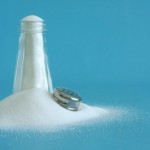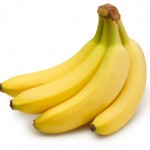I remember a Biblical reference (Genesis 9:26 in my copy) to Lot's wife looking back at Sodom and Gomorrah and turning into a pillar of salt. Today I'd like to talk about much smaller amounts than a whole pillar and salts in the pleural, not just sodium chloride, ordinary table salt, but potassium as well.
I am aware there's been considerable discussion of our dietary salt/sodium intake in the past few years. A July 12, 2011 article in The Wall Street Journal titled "Neutralizing Sodium's Heart Impact" led me back into this literature.
We've been urged time and again to lessen our sodium intake. The 2011 Dietary Guidelines, as I've mentioned before, suggested the average American cut their sodium intake from our average of 3,400 milligrams down to 2,300, roughly a teaspoon a day.
But a large group of us, all at risk for hypertension: everyone over 51, African-Americans, anyone with pre-existing high blood pressure and those with diabetes or chronic kidney disease (i.e., over half our population) were told we should go further, cut to roughly a half teaspoon of salt a day, with various sources suggesting 1,200 to 1,500 milligrams per day total sodium intake.
The most recent study appeared in the Archives of Internal Medicine on July 11th and had a slightly different take on the subject. A prospective cohort study of 12,00+ US adults, followed nearly 15 years, showed that both lower sodium intake and higher potassium intake were associated with a lower risk of death.
The numbers appear significant with the quartile i.e., quarter of the group, ingesting the highest sodium to potassium ratio having almost one and a half times the death risk of those who ate the lowest ratio. That held true for all-cause mortality and the death risk for ischemic heart disease was over two-fold in the group who ate more sodium and less potassium-containing foods.
So how do we get more potassium in our diets and just how much should we be ingesting? I found a lovely illustrated guide on the umassmed.edu website and another good discussion on MedlinePlus, the NIH website. The former guideline has both potassium and calorie data.
Adults with normal kidney function should be getting 4.7 grams a day from the foods they eat (if you have reduced kidney function, ask your own physician how much you should ingest). Some medicines affect your ability to excrete potassium; for the rest of us 19 and older the Food and Nutrition Center of the Institute of Medicine says the 4.7 gram amount is reasonable. Nursing moms need 5.1 grams a day.
A large baked potato with skin has 845 milligrams of potassium and 160 calories while 1/2 of a medium sized cantaloupe has 680 milligrams and only 60 calories. A medium banana has 451 milligrams with 105 calories.
Red meats, chicken, salmon, cod, flounder and sardines are all good sources of potassium and a cup of low-fat plain yogurt has 530 milligrams with 150 calories.
Many of us have eaten far too much sodium (in processed foods) and too little potassium.
It's time for a change.



I always learn so much when I read your blog. You should add a "Subscribe by email" button so this will be sent to my email every time you add a new post. 🙂